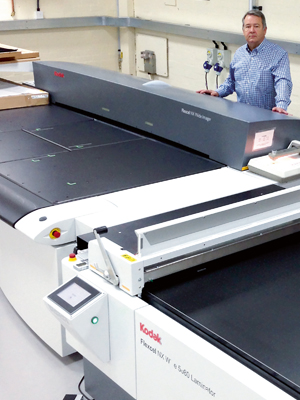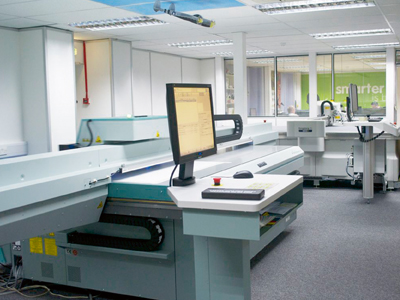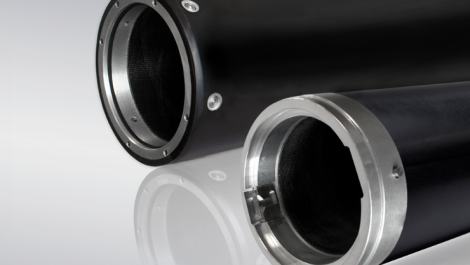The Sherwood Press Smart Centre with the Fujifilm Acuity Advance Select HD4006
Carton manufacturers are intent upon ensuring that there is sufficient common ground on which to develop greater confidence within their customer base on their ability to meet ever more challenging expectations, reports Des King.
The potential for a sudden hiatus in the availability of given grade of board is a defining characteristic of the carton supply chain that has been long recognised by converters and customers alike; the price – as much in frustration as in financial terms – of keeping faith with this particular packaging format. It is, however, maybe less easy to accept in a sector that is increasingly coming under pressure as brand owners and retailers expect a combination of greater flexibility and shorter lead-times. Are carton manufacturers up to the challenge? And is there anything that flexo printers can learn about nurturing closer customer relationships from their predominantly offset litho equipped counterparts.
If the upbeat mood amongst converters attending a recent one-day workshop organised for its members by BPIF Cartons was anything to go by, then absolutely yes. It is a positivity based as much as anything else on the security of the common ground that has been painstakingly cultivated over the years bridging either end of the supply chain. According to a recent research programme amongst brand owner and retailer end-users of carton packaging conducted by independent sector consultant Tony Hitchin, levels of satisfaction run high with the service they’re receiving, and with the provision of both value for money and innovative solutions scoring particularly well.
‘Packaging buyers clearly have an affection for cartons; they fare well in research with consumers too, not least with their unique environmental credentials,’ reports Mr Hitchin. ‘It is therefore reassuring to hear that the service which UK converters provide at least matches the aspirations of brand owners and retailers for whom the carton is the packaging format of choice.’
BPIF Cartons general manager Neal Whipp is equally impressed by the results of the survey – and quick to note the opportunities it presents to carton buyers for improved communication. ‘Converters must empathise with market pressures to shorten lead times. They can do this by using digital technology to totally clarify the standard of reproduction they will achieve at mock up stage and then use the controls that are integral to attainment of ISO 12647 to maintain the approved result throughout the run. Standing a press for hours while negotiating to achieve a new shade of colour must be a thing of the past.’
Other key findings included a growing preference amongst carton users for longer-term contracts – particularly so for premium and top-end products – that can extend on occasion to anything upwards of five years; and the capability of being able to manage both long and short runs. In that latter respect, however, was a relatively low level of interest in or take-up of digitally printed cartons – by and large still considered to be a niche application.
That’s not so surprising at the present time, says Neal Whipp. ‘The instincts which drive digital investment continue to take the carton industry forward. If the rate of change is slower than that seen in flexibles or labels then it reflects the very different factors that dominate carton print press productivity, not a reluctance to embrace change.
‘As and when new press technology facilitates cost savings however it will also be necessary for brand owners and retailers to recognise that suppliers must retain some of those savings within the business. The downward pressure on price must be considered a long term strategy – not simply a matter of ‘take 10% off our price today if you want the business next week’.’
A matter of give and take
Whilst respondents to the research struggled to suggest ways in which their existing carton suppliers could improve upon levels of service – apart from ever more flexibility and reducing lead times – the need for transparency and more understanding of the customer’s business model ranked high on their overall wish list of how best to go forward.
Not that it necessarily always appears to obtain in reverse, however, with shortening lead-times often compromised by what are invariably avoidable delays to the process on the customer side. Whilst most carton manufacturers enjoy very good partnerships with some customers, it’s quite common for artwork to be promised on a certain day but for the converter to still be chasing the customer for it two weeks later. Meanwhile, the delivery date remains set in stone.
In mitigation, the fault might very well not reside solely with the brand owner but more often right from the supermarkets, whose demands are simply passed down the line leaving the printer with no other option than to make up the short-falls that occur in the middle. So whilst converters might like to think they’ve fully investigated the supply chain ahead of the project; the reality is that things that are totally unanticipated can and do crop up.

Keith Mollan with the Kodak NX plate system at Pulse Media
The way in which a job progresses through its several approval stages will depend upon who is the point of contact within the client company. ‘Quite a few of our customers have their own in-house artwork management teams. That’s great as there’s mutual understanding, not just in terms of proficiency but also what are realistic timelines,’ says Pulse Media managing director Keith Mollan. ‘Conversely, trying to manage a timeline with a marketing person with very little understanding of the process can be like pushing snow uphill.’
Sampling the goods
Tony Hitchin’s research flagged up a clear preference for being able to see physical samples prior to launch; a provision with which an increasing number of carton makers are happy to comply. ‘Much can be achieved if digital origination is shared early and conditional approval given for mock up proofs using the final pack material,’ notes Neal Whipp. ‘Use of the latest repro technology should also benefit time and cost by eliminating the need for on-press approvals, approval of the final mock-up being all that’s needed.’
Mr Mollan is in full agreement. ‘Customers want to physically hold a sample. A lot of our customers have their own facsimile store interiors, so they’ll place a sample or a prototype pack alongside their competition to see how it stands out on-shelf, to see whether the colours need more work.’
The Sherwood Press Group established its own dedicated ‘Smartcentre’ innovation facility 16 months ago, with a Fujifilm Acuity Advance Select digital press and a Kongsberg XN digital cutting system as part of a £250,000 investment programme, said Sherwood Press CEO Jeremy Bacon.
‘Whilst we had been traditionally producing packaging samples using the litho presses, we considered the introduction of a digital print device to improve our time to market. The Acuity press appealed to us due to the quality of its output and its ability to print four colours plus white directly onto a variety of rigid and flexible materials, including corrugated board. What’s more, the opportunity to print spot varnish is crucial for the packaging industry and was a key selling point of the Fujifilm machine.’
The Kongsberg system is used to cut intricate shapes following a CAD profile, complementing the high quality print produced on the Acuity, and both machines have broadened Sherwood’s in-house capabilities and product portfolio, including short-run prototype samples and low volume production of POS products.
Jeremy Bacon concluded: ‘The strength of the Smartcentre encompasses the central values of Sherwood Press in providing excellence in everything we do. Not only is this reflected in the creativity and technical experience of the Smart team, but also in the capability of both machines to enable us to provide the highest quality mock-ups and prototypes, on any stock with almost any finish.’
Supply and demand
Whilst repro specialist Keith Mollan is full of praise for the capabilities of the carton sector to not only deliver what the customer wants but quite often a solution far better suited to meet their needs, the ever-present elephant in the room is board supply; a presence he cautions that can lead to dire consequences.
‘There can be a lead-time of six to 12 weeks to get material. In fact, at certain times of the year board manufacturers used to shut down capacity and create demand; thus taking flexibility out of the very market sector they should be supporting. Correspondingly, because they hold stocks of polymer and blow their own film, flexible converters can make material one week and print it the next. Added to that, the quality of flexo print has grown over the past five to seven years. We have moved a number of products across into flexibles, some of which have been packaged in cartons for over 20 years.’
It’s a threat that Neal Whipp is quick to refute. ‘BPIF Cartons is fiercely committed to ‘fitness for purpose’ as the key driver that determines which packaging material is used. Occasions where flexible packaging can replace cartons must on this basis be very rare. Certainly the tonnage of cartons produced in the UK continues to increase year on year albeit by small degrees. If there have been end-use switches – for instance in the packaging of sandwiches – then the change has favoured cartons not the reverse. If you want to achieve a premium product image then the carton remains popular. If price is more important than protection or branding image then maybe a simple film wrap will prevail.’
In the meantime, most carton manufacturers have developed practical coping strategies – often in collusion with their customer-base – that renders the likelihood of work migrating from board to film as negligible. It’s reflective of a positive transparent partnership that most customers are very aware and know that board supply can be subject to as long as a 16 to 18-week delivery. Whilst it is customary to ask for a specified board, it’s standard practice to flag up a like for like alternative at the time of order so end users have the option of realising improved lead-times if the job demands it.






